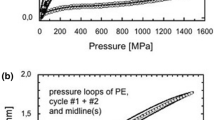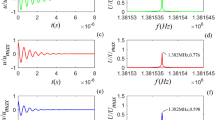Abstract
The article reports the results of spectral-correlation analysis of elastic waves generated by a high-velocity piston in a silicon carbide powder. Sound was found to be dispersed intensively in the frequency range from 0 to 500 Hz while elastic waves with frequencies higher than 500 Hz were observed to propagate without dispersion in the compactible powder. Waves of comparatively low frequency perform most of the work of compacting SiC particles. Those waves also ensure that the compacts have a high density, even in the case of a non-plastic material as silicon carbide. Pulsed-vibratory compaction of products made of non plastic powders during ceramics production is one of the most effective vibratory compaction methods. A pulse of elastic vibrations is introduced into the compact by means of an electric discharge in a liquid, in essence, an underwater electrical explosion [1].
Similar content being viewed by others
References
A. I. Ivliev, P. P. Malyushevskii, G. G. Gnesin, et al., “Sydy of the process of pulsed-vibratory compaction of powder materials,” in: Theory and Practical Application of the Electrohydraulic Effect [in Russian], Nauk. Dumka, Kiev (1985), pp. 98–102.
P. P. Malyushevskii and A. B. Tolstykh, “Use of the electrohydraulic effect in powder metallurgy,” Poroshk. Metall., No. 5, 22–26 (1979).
J. Max, “Fundamental Principles and Classical Methods,” in: Signal Processing Methods and Technique in Physical Measurements. Vol. 1 [Russian translation], Mir, Moscow (1983).
J. S. Bendat and A. G. Piersol, Engineering Application of Correlation and Spectral Analysis, Wiley, New York (1980).
I. A. Chaban, “Spatial dispersion of the velocity of sound in emulsions,” Akust. Zh.,19, No. 6, 926–929 (1973).
A. I. Potapov and N. P. Semerikova, “Nonlinear longitudinal waves in a rod with allowance for the strain and temperature fields,” Zh. Prikl. Mekh. Tekh. Fiz., No. 1, 57–61 (1988).
G. N. Savin, A. A. Lukashev, and E. M. Lysko, “Propagation of elastic waves in a solid with a microstructure,” Prikl. Mekh.,6, No., 7, 48–52 (1970).
Additional information
Institute of Pulsed Processes and Technologies, Nikolaev and Institute of Materials Science Problems, National Academy of Sciences of Ukraine, Kiev. Translated from Poroshkovaya Metallurgiya, Nos. 5–6, pp. 1–7, May–June, 1996. Original article submitted June 9, 1994.
Rights and permissions
About this article
Cite this article
Petyur, L.G., Miroshnichenko, E.K., Malyushevskii, P.P. et al. Changes caused in the physical properties of a powder by an electric explosion. Powder Metall Met Ceram 35, 219–223 (1996). https://doi.org/10.1007/BF01328821
Issue Date:
DOI: https://doi.org/10.1007/BF01328821




